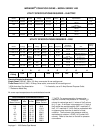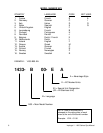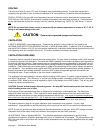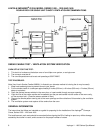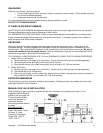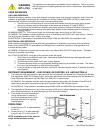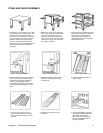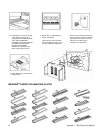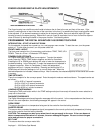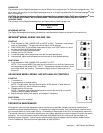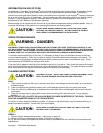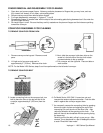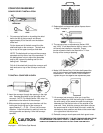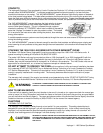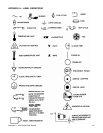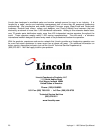
Impinger I – 1000 Series Ops Manual
15
INFORMATION ON USE OF OVEN
As explained in “Concepts,” the Impinger
®
oven functions by directing high velocity streams of heated air directly
on the food products. Because air is the heat source, it is effective even on sensitive foods. Compared to
conventional ovens and even convection ovens, the cooking time of products in the Impinger
®
Conveyor ovens can
be as much as two (2) to four (4) times faster. Several factors may affect the cooking time of any special product
such as: 1) oven temperature setting, 2) conveyor speed, 3) position of columnating plate in oven, and 4)
adjustments of the 2 baffles on the conveyor openings.
We encourage you to experiment with the oven by trying different temperature settings and belt speeds. Also, try
to control the cooking of the product by re-arranging the optional columnating plates.
OPERATOR MAINTENANCE
DISCONNECT POWER SUPPLY BEFORE SERVICING OR CLEANING THIS OVEN. SAFEGUARD POWER SO IT CAN
NOT BE ACCIDENTALLY RESTORED. FAILURE TO DO SO COULD RESULT IN DISMEMBERMENT, ELECTROCUTION,
OR FATAL INJURY. THERE IS MORE THAN ONE POWER SUPPLY CONECTION POINT WHEN OVENS ARE STACKED,
SO MAKE SURE THAT ALL SWITCHES ARE IN OFF POSITION BEFORE CLEANING OR MAINTENANCE.
To maintain maximum efficiency of the oven, it is necessary to keep it clean, all ventilation louvers on the oven
must be cleaned regularly. Oven use and type of product will actually determine the frequency of cleaning. The
conveyor drive chain should be checked during the weekly cleaning cycle to see if it has become loose. Loose
chain operation will DAMAGE the conveyor drive motor.
If the oven fails to operate, check the circuit breaker to be sure it is turned on. Also, check the fuses on the control
panel to be sure that they are good before you call the Authorized Service Agency. The name and phone number
of the Authorized Service Agency should be located at the bottom of the data plate.
CLEANING INSTRUCTIONS
DAILY
1. Clean exterior surfaces of the oven by wiping it down with a mild detergent and clean water, or a commercial
stainless cleaner.
2. Clean crumb pans and guards by washing with a mild detergent solution and rinsing with clean water.
3. Clean the interior by sweeping up all loose particles, then wash with a mild detergent solution and rinse with
clean water.
4. Clean the conveyor belt by wiping with a clean cloth or brushing with a soft wire brush. Lincoln catalog
#369217.
NOTE: DO NOT USE A CAUSTIC OR ALKALINE BASE CLEANER ON INTERIOR OF THE OVEN. THIS WILL
RUIN THE ALUMINIZED FINISH OF THE OVEN INTERIOR.
On exterior of oven, deposits of baked-on splatter, oil, grease, or light discoloration may be removed with any of
several commercial cleaners. Consult with your local supplier.
WEEKLY
1. Remove fingers, disassemble and clean. Instructions on page 16.
2. Remove conveyor, disassemble and clean. Instructions on page 16.
NOTE: Be sure to clean and inspect the ventilation hood in accordance with the ventilation hood manufacturer’s
specifications.
CAUTION:
DO NOT WORK AROUND CONVEYOR BELT WITH LONG HAIR, LOOSE
CLOTHING, OR DANGLING JEWELRY. GETTING CAUGHT IN THE BELT
COULD RESUL
T IN DISMEMBERMENT OR FATAL INJURY.
WARNING
-
DANGER:
!
CAUTION:
OVEN MUST BE COOL. DO NOT USE POWER CLEANING EQUIPMENT, STEEL
WOOL, OR WIRE BRUSHES ON STAINLESS STEEL SURFACES.
!
!
CAUTION:
WHEN USING CLEANING SOLUTIONS, BE SURE THEY MEET LOCAL AND
NATIONAL HEALTH STANDARDS.
!



